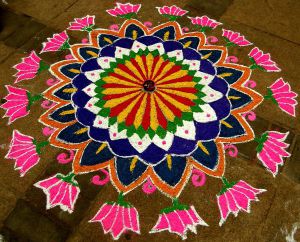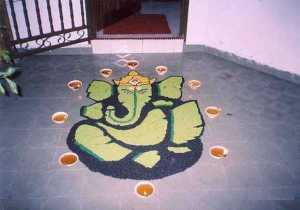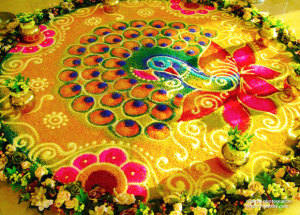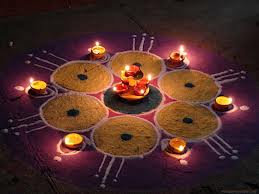Rangoli is a painting made on the ground in a particular technique. This is a very common and popular art in India.

The rangolis are often made on the ground in yards or before the doorsteps. We find even more particularly in the (many) festivals, where they take the scale to honor the gods. In addition to the decorative appearance, they are also meant to protect the family and bring good luck.
The designs can be small or very elaborate. They vary depending on location and the States where they are designed and are often made by women.
Although the materials used are not “noble”, the result is often spectacular and colorful. Used rice or dried powder, colored sand, chalk, coal or wood sawdust, which is sometimes decorates flower petals. The patterns are usually made on the ground in the middle of yards, to the bearings in the common areas or in the corners. The rangolis are now used in the middle of the hotel to decorate in an unusual and funny way.
The pattern vary: most of the time they are inspired by natural elements, but it can also be abstract figures. Symbols, or Utswdhermita are signs auspicious in Indian culture: flower and lotus leaves, mango, fish, different birds like the peacock, swan, parrot …
there are also human figures. For the festival of Diwali, there are also many gods Ganesha and Lakshmi.

Technical implementation, pretty basic, can be a meticulous learning, depending on the sophistication of the work performed.We distinguish the “dry” technique and technology “wet”. It begins by tracing the contours (usually chalk) before filling colors (colored powder or rice). There are also many stencils on the market.
Tradition has it that the forms are completed more square in northern India, more hexagonal south while Rangoli Onam (festival which takes place in the South in September-October) are circular.
Home made rangoli
Rangolis have different names from the area of origin:
– Chhattisgarh –> chaookpurna
– Rajasthan –> mmandn
– Bihar –> aripan
– Bengal et Maharashtra –> alpana
– Karnataka –> rangavallie
– Tamil Nadu –> kollam
– Andhra Pradesh –> muggu
– Kumaon –> alikhthap
– Kerala –> kolam
– Gujarat –> saathiya


 Français
Français
